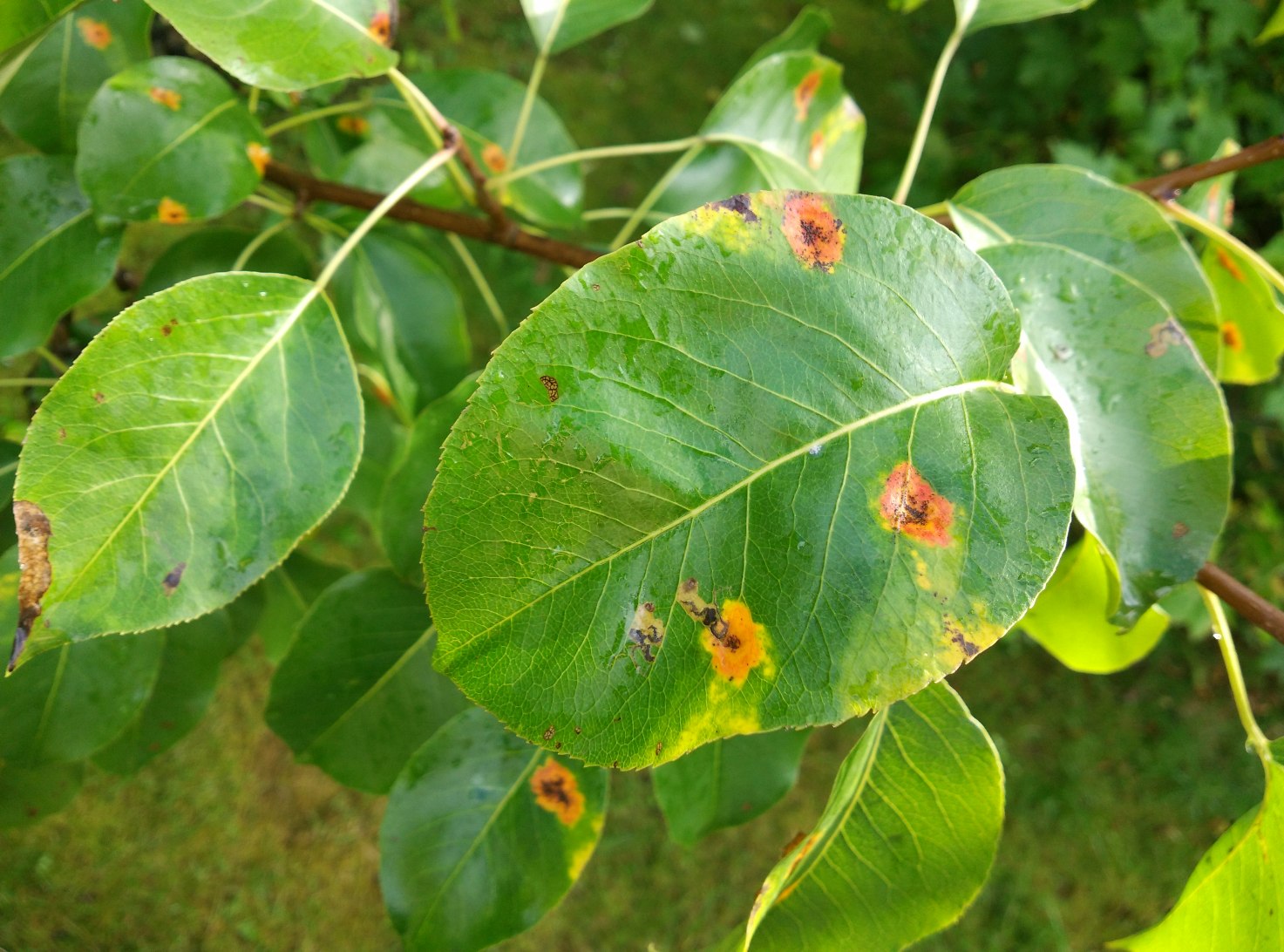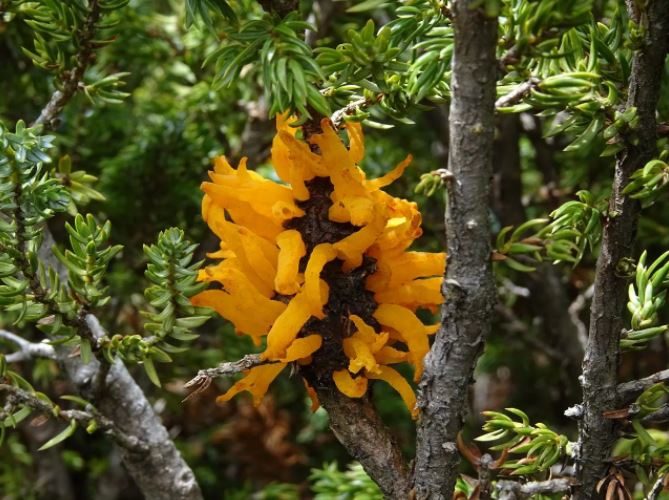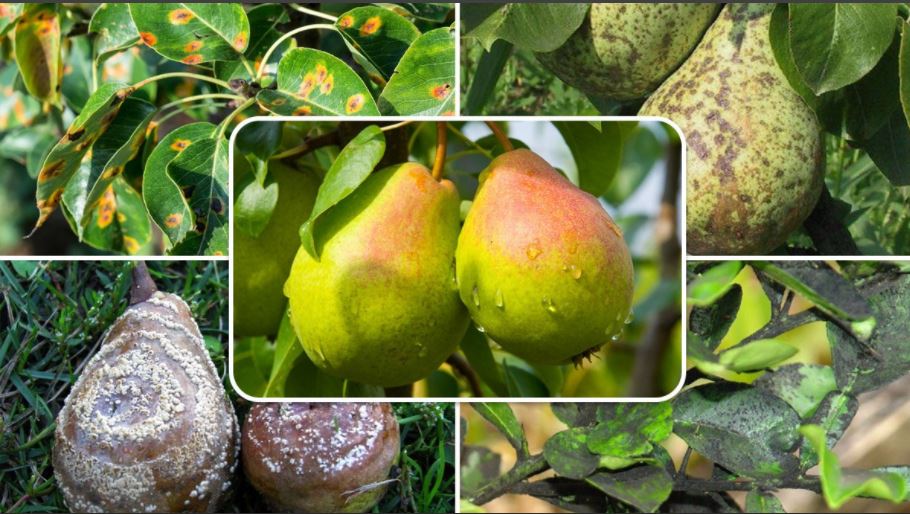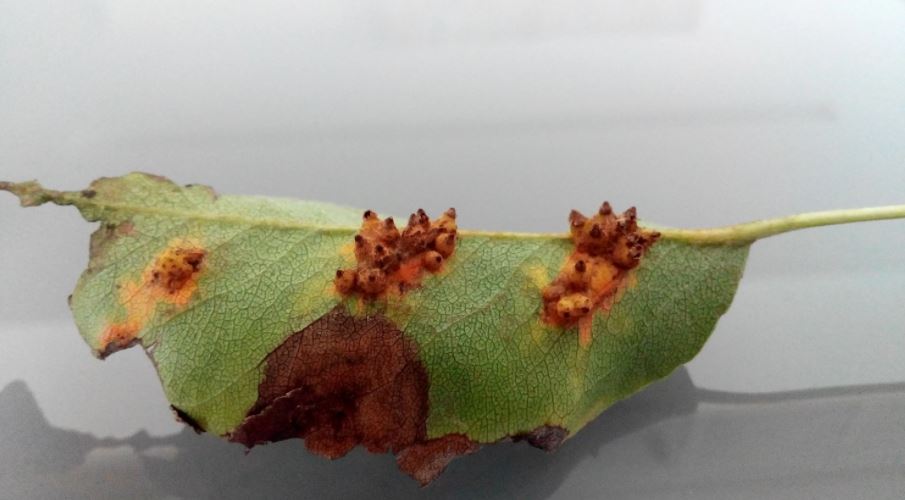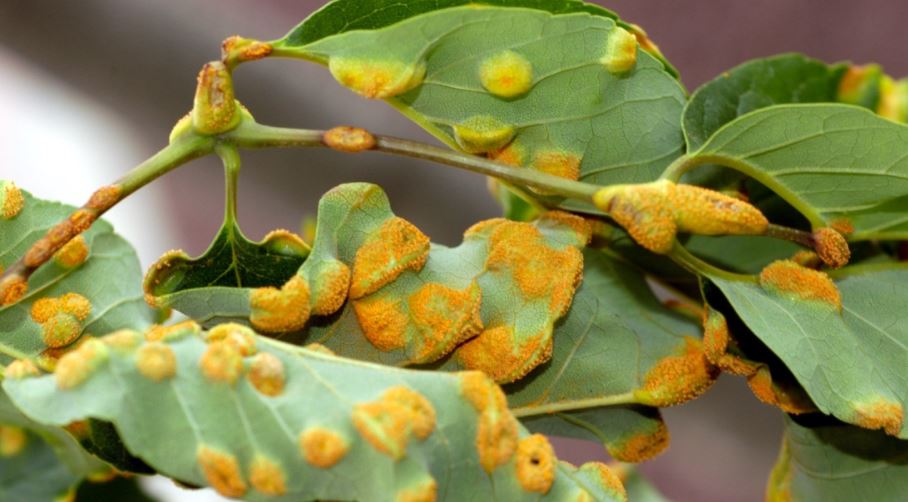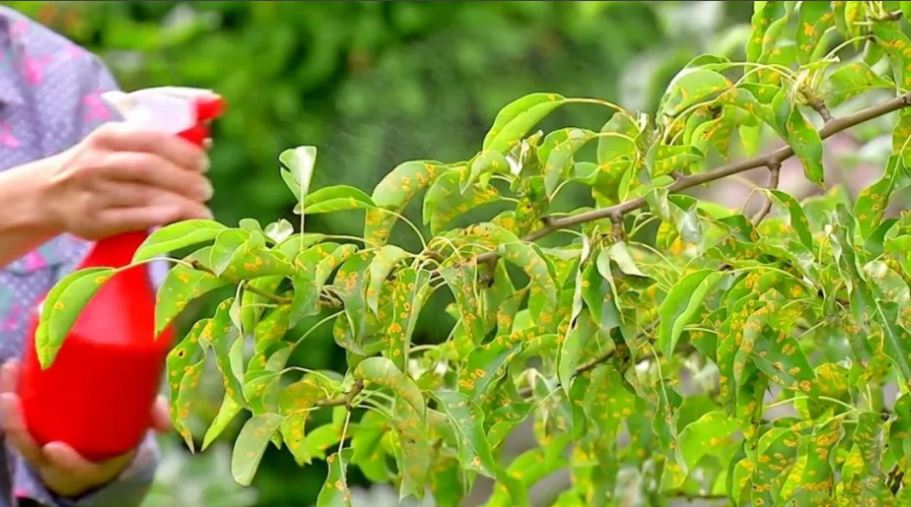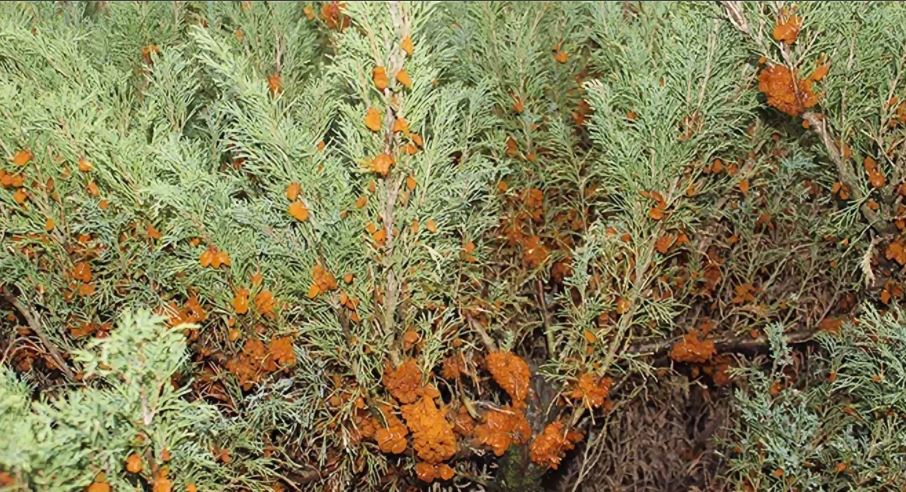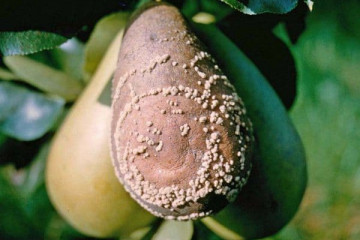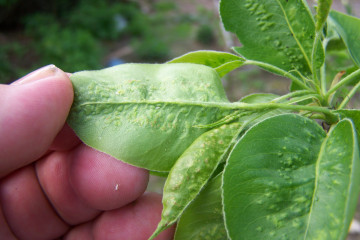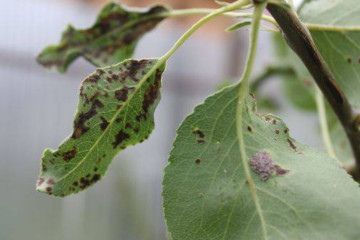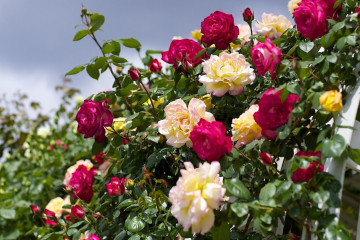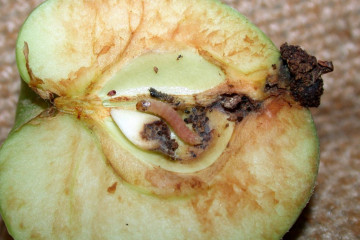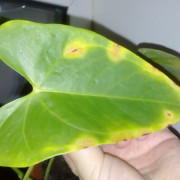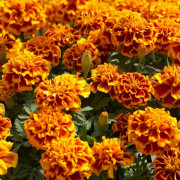Rust on a pear - what to do and popular remedies
Content:
Pears are delicious, juicy and very fragrant fruits, and seedlings are not very whimsical to care for. However, budding gardeners may have trouble growing pear trees. This is due to the fact that some varieties are subject to a fungal disease, which is quite difficult to cope with if you do not take timely measures.
What is pear rust
Rust is a fungal disease that can kill fruit trees if timely measures are not taken to prevent and treat seedlings.
An interesting fact is that rust itself does not appear on fruit trees. This disease appears exclusively on the juniper, if it has not been properly cared for, and then it can spread through fruit trees in the process of transferring fungal spores by the wind.
Features of the development of the disease
The reason for the appearance of rust on seedlings is the development of the fungus Gymnosporangium sabinae directly on the juniper. One of the main features of the development of this disease is that, thanks to spores, it wanders from juniper to pear, and then vice versa. The foliage can rust even from the moment the buds open, and then it covers the whole tree with spots that has a red color.
Signs of defeat
As for the question of how to recognize the signs of a disease on a pear, you can notice them even in early spring. The fact is that on a tree affected by a fungus in the spring, when the foliage blooms, red-orange spots are visible on it. Sometimes "rusty" areas may have bright red and black stripes edging.
You should also pay attention to the foliage. If the seedling has undergone a disease, then the young leaves grow very slowly, and often remain small in size, while the foliage becomes denser in structure.
In the case when cracks appear on the pear tree, and on its large branches and bark, this indicates the presence of a disease. In addition, it is already obvious here that the disease has reached a large scale.
How does rust develop on a pear
Rust is not just a dangerous disease - it also develops quickly enough. From early spring until the end of the growing season, the tree can be completely affected by the disease. And it all starts from the moment the leaves bloom in the spring.
A small amount of red-orange spots, the so-called "neigh" spreads throughout the foliage of the pear tree with lightning speed. It should be said that if no measures were taken to treat the seedling, not only the leaves, bark of the tree, but also its fruits can be affected by rust. The phasing of the development of the disease is as follows:
- Initially, spots of rich orange appear on the foliage, which are outlined along the edges with a red stripe.
- Further, signs of rot begin to appear on the tree, but this is just the formation of gray stains on the foliage.
- Then, on the lower part of the leaves, tubercles are formed of the same color as spots at an early stage of the disease. The growths are inhabited by spores of the fungus, in which they develop and mature, and then are carried by the wind over a very long distance.
It should be said that the affected foliage crumbles to the ground early, and spores that did not have time to be spread by the wind fall into it. But a tree, if rust has covered most of the branches and the trunk on it, can simply dry out even before the beginning of autumn.
Effects
Spores of the fungus Gymnosporangium sabinae can ripen several times in one season, but there are other equally serious consequences of such a disease for the pear tree. The main ones are:
- Leaf fall with rust occurs ahead of schedule.
- New shoots on a seedling can grow very slowly, and then dry up completely.
- Fruits on a rusty tree become very small and lose their original taste. In addition, the shape of the pear can be deformed.
Among the negative consequences, a decrease in the immunity of the seedling should be noted, so it practically cannot withstand various diseases.
Why rust is dangerous for pear trees
The main danger is that the tree, if completely infected, may die. Although stunted growth, deformation of the fruit are also negative consequences for the pear if it has undergone a disease. The complete loss of the crop is also an unpleasant event.
Treatment and processing of wood
Rust is a rapidly spreading disease and is difficult to treat. If you do not take timely measures, then the fungal disease can also spread to other seedlings in the personal plot. Therefore, it is better to try to prevent the disease than to fight it later.
Drastic measure - removal of leaves, branches
In the case when the first signs of rust appear on a pear or juniper, you should immediately begin to fight this disease. If the foci of infection are quite extensive and the growths on the foliage begin to increase, then drastic measures should be taken.
In this case, you need to carefully (so as not to distract the spores) to cut off the branches or eliminate the affected foliage. After them, it is imperative to burn them, but this must be done outside the personal plot.
How to process with a chemical method
It is necessary to use chemicals only when it is cool outside, this is in early spring and late autumn. At the same time, the processing of trees should be done carefully so that chemicals do not get on the skin and mucous membranes. If this nevertheless happened, then it is imperative to thoroughly rinse your eyes and wash off the solution that has got on it from the skin.
Other precautions should also be noted:
- It is necessary to carry out processing in dry and calm weather.
- It is best to spray the crown of a tree in the morning or evening, when the sun's rays are not so burning.
- It is recommended to use special protective equipment, this will eliminate the risk of contact of the chemical on the skin.
Chemical processing.drugs cannot be produced when there is a sultry heat outside, because there is a possibility of getting poisoned from the evaporation of the chemical solution used.
Spraying preparations
When yellow spots appear on the leaves of a pear, how to treat and what drugs can be used are questions that seem difficult only at first glance. Rust is afraid of products that contain copper and sulfur.
How to get rid of folk remedies
If there is no possibility or desire to use chemicals to remove rust on the pear, you can use several types of folk remedies. The most effective solution is urea (700 grams per 10 liters of water). It is necessary to spray with such a remedy in the fall, when all the foliage crumbles on the tree. In this case, it is imperative to loosen the soil near the tree for the winter. As a recommendation, a few more tips should be noted:
- Every year, after the leaves fall from the tree (in autumn), it must be removed and burned outside the site.
- It is imperative to loosen the soil in the root zone if watering has been carried out or good rain has passed.
- The pear should be fed with fertilizers that contain potassium and phosphorus.
- You can use as a preventive measure an infusion of wood ash, sprinkling it on the tree before the buds begin to bloom.
If possible, you need to remove the juniper from the personal plot. This will be a good solution to eliminate the main source of rust pathogens.
Fungicides for pear rust
Today, in specialized agricultural stores, you can buy drugs that can help fight rust on trees, including pears. Some of the funds are intended to treat not a specific fungal disease, but several of their varieties at once. Therefore, if a drug is used for complex treatment, it is not necessary to use it after the remedy for each type of disease.
How to deal with rust on a pear with copper-containing preparations
Preparations that contain copper are today one of the best means in the fight against fungal diseases in garden and horticultural crops.
Copper sulfate is considered the most effective remedy capable of curing even rust on seedlings. It is worth clarifying that the pear should be processed in the spring before bud break as a preventive measure, and in the fall, when the foliage will fall off the seedling. This will destroy the spores of the fungus if they linger on the branches. It is imperative to process the tree trunk, since rust spores can also hide in the bark.
How to treat yellow spots on pear leaves with colloidal sulfur
If a spot appears on the foliage, indicating the presence of rust, then colloidal sulfur can be used to treat the pear seedling. It is sold in powder form in agricultural stores, but even these small granules do not dissolve well in water. To speed up the process, it is recommended to pre-crush the granules. Colloidal sulfur is diluted in a ratio of 40 grams per 10 liters of water, and then the pear tree should be completely sprayed with the resulting solution. The number of treatments should be 5 times, namely:
- in early spring, when the vegetative period has not begun;
- until the formation of buds;
- when the pear is blooming;
- during the formation of fruits on the seedling;
- after the harvest has been harvested.
Additionally, spraying should be done when all the foliage has fallen from the tree, but it is advisable to do this before the onset of frost.
What preparations to spray a pear against rust
To cure a pear tree from rust, it is necessary to use special agents, fungicides. The fact is that they contain copper and sulfur, which are effective against rust.If even small rusty spots appear on the leaves of the pear, you need to spray the tree with one of the following preparations. In the description of each, its own advantages and disadvantages are noted, which will make it possible to determine when and how they should be applied.
The drug "Polyhom" under the trade mark "Iskra"
You can use it for processing no more than 5 times per season. Despite the fact that Polychom is not a toxic agent, it is not recommended for them to spray trees if they are in close proximity to fishery reservoirs.
Bordeaux liquid of the Green Belt trademark
It is permissible to spray pears with Bordeaux liquid within 6 times during the growing season of the seedling. This drug is quite effective, and it can also be combined with various pesticides. As for compatibility with fungicides, it is forbidden to use them together, especially if they tend to degrade in an alkaline environment.
The drug "Balleton" under the trademark "Green Belt"
The number of treatments should not exceed 2 times. Cannot be used near water bodies, it can be dangerous for warm-blooded individuals. Among the advantages can be noted compatibility with most chemicals designed to combat diseases. The disadvantage is the quick addiction of pests to it, and fungi and bacteria develop resistance to it.
The drug "Strobi" brand "BASF"
If the pear tree starts to ache with rust, you can try to treat it with Strobi. This tool is a new generation fungicide and has established itself as the most effective drug in the treatment of pear rust. At the same time, it does not contribute to addiction to it and is used even during the beginning of flowering. The same applies to the "Horus" device.
The drug "Raek" brand "August"
A quick assistant in the fight against rust on fruit trees, this is the preparation "Raek". It should be applied no more than 4 times, but it cannot be processed trees if they grow close to water bodies.
Additionally, it is worth mentioning such a drug as "Fitosporin": it does not just fight various fungal diseases on plants, but can serve as a good prophylactic agent.
Features of treatment at different times of the year
Rust treatment and disease prevention should begin in early spring, that is, until the buds begin to bloom on the pear. It is worth focusing on temperature indicators: if the air warms up to zero degrees and frosts are not expected, then you can start processing the seedlings.
This applies to chemicals, but new generation fungicides, such as Topaz, can only be used if the temperature outside does not drop below 15 degrees. It is worth highlighting one nuance. It is not recommended to use fungicides on hot days, that is, at +30 and above. In summer, it is mainly June and July.
Rust resistant pear varieties
Pears are considered to be those types of fruit trees that are often subject to various diseases, including rust. Although there are several varieties of pears that are more resistant to such diseases.
Dukhmyannaya
The pear of this variety is considered to be of medium height, and the crown of the tree is wide-pyramidal in shape. The fruits are green in color, but they develop a brick-red blush when ripe.
As for the taste, the pulp is snow-white, juicy, sweet and sour. You can harvest in August or early September. The fruits can reach a weight of about 140 grams and have a shelf life of about 45 days.
Severyanka
Severyanka, like Dukhmyannaya, is a medium-sized pear tree. Despite the wide-pyramidal shape of the crown, it has an average thickening. The fruits themselves are quite juicy and sweet, and the pulp is creamy.The weight of pears can vary from 80 to 120 grams.
Tikhonovka
In the pear variety Tikhonovka, the crown can be either wide-pyramidal or round in shape. The difference is related to the age of the tree. The fruits are small, about 60-90 grams each. The peel of the pear has a green color, is firm, and the pulp, despite the juiciness, is quite crispy. You can enjoy the harvest in September.
One of the significant advantages is that the shelf life of the fruit is about 270 days.
In memory of Yakovlev
The height of the tree does not exceed 3 meters, and the crown is round and has medium thickening. Pears are light yellow in color, and when fully ripe, a blush of a pale pink hue appears on them. The pulp is juicy, creamy white and even slightly oily. The fruits can reach a size of 120 grams, and you can eat them only in September and October. Once harvested, pears can be stored for up to 120 days.
Unstable varieties
In order not to be upset about the loss of the crop, not to worry when looking for means to fight rust, you should know the varieties of pears that are not able to withstand it. It is not recommended to plant pears of the following varieties on the garden plot:
- Favorite;
- Clappa;
- Bere Ardanpon;
- Curé;
- Dikanka is winter.
Additionally, it must be said that even if the pear variety is capable of resisting fungal diseases, including rust, you should not risk planting a juniper on your garden plot. After all, it is this plant that is the causative agent of the disease.
Prophylaxis
Rust is a rather complex fungal disease, since it is not only problematic to fight it, but it can also take a long time. Sometimes it takes several years to rid the seedlings of rust. Therefore, it is recommended to do prophylaxis annually and prevent the disease from progressing.
In conclusion, it should be said: to deal with the question of how to treat rust on a pear should be done in advance, before the disease affects the whole tree. Many people simply do not attach importance to small specks and it is completely in vain. Rust spreads very quickly. In the presence of favorable conditions (moisture and heat), the tree becomes completely infected during the summer.
